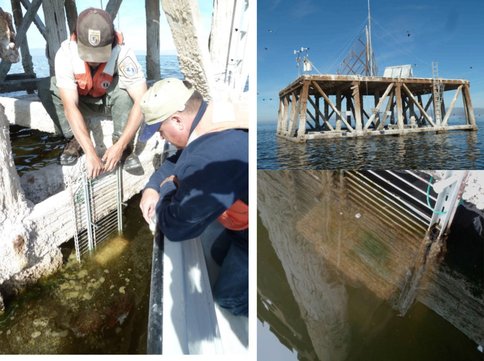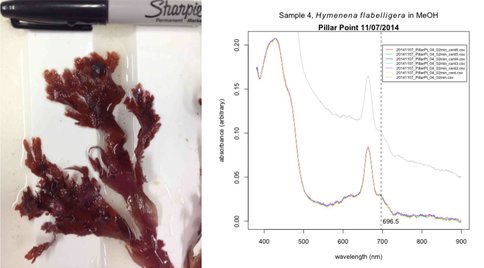2014 Annual Science Report
 VPL at University of Washington
Reporting | SEP 2013 – DEC 2014
VPL at University of Washington
Reporting | SEP 2013 – DEC 2014
The Long Wavelength Limit of Oxygenic Photosynthesis
Project Summary
Oxygenic photosynthesis (OP) produces the strongest biosignatures at the planetary scale on Earth: atmospheric oxygen and the spectral reflectance of vegetation. Both are controlled by the properties of chlorophyll a (Chl a), its ability to perform the water-splitting to produce oxygen, and its spectral absorbance that is limited to red and shorter wavelength photons. We seek to answer what is the long wavelength limit at which OP might remain viable, and how. This would clarify whether and how to look for OP adapted to the light from stars redder than our Sun.
Previously under this project, with other co-investigators we spectrally quantified the thermodynamic efficiency of photon energy use in the chlorophyll d utilizing cyanobacterium, Acaryochloris marina str. MBIC11017, determining that it is more efficient than a Chl a cyanobacterium. The current focus of the project is aimed at understanding the adaptations of far-red/near-infrared (NIR) oxygenic photosynthetic organisms in general: what is their ecological niche where they are competitive against chlorophyll a organisms in nature, and what energetic shifts have been made in their photosynthetic reactions centers to enable their use of far-red/NIR photons. Field sampling and measurements are being conducted to isolate new strains of far-red utilizing oxygenic photosynthetic organisms, to quantify the spectral and temporal light regime in which they and previously discovered strains live in nature, and use these light measurements to drive kinetic models of photon energy use to ascertain light thresholds of survival.
Project Progress
Samples were obtained from three different field sites, to isolate strains of the chlorophyll d utilizing cyanobacterium Acaryochloris marina, and preliminary installations were made at one site to quantify its in situ light environment.
At the Salton Sea, California, where a strain of A. marina was previously discovered and of which Blankenship maintains lab cultures, Kiang made several visits to locate areas where A. marina is actively growing. Kiang partnered with JPL scientists, Simon Hook and Bill Johnson of the ASTER and HyTES missions to install settling plates at their meteorological platform in the Salton Sea in January 2014, to grow biofilms for field and lab measurements of community structure, light spectral transmittance and reflectance, and in situ incident spectral irradiance. Plates were installed at two different depths in the water and successfully grew biofilms. Unfortunately, chemical corrosion by the highly polluted waters caused the installation to disintegrate after 6 months and before the plates could be retrieved. Plans for a hardier installation are in progress.
At Pillar Point, Half Moon Bay, and Moss Beach, California, Kiang and Parenteau collected red algae samples and found evidence of Chl d on a sample of the red macroalga Hymenena flabelligera, through pigment extracts and spectral analysis. After this preliminary survey, another field visit is planned for March 18, 2015, partnering with Dr. Kathy Ann Miller, the Curator of Algae at the University Herbarium at UC Berkeley. Identification of Chl d will be done by HPLC in the labs of Blankenship and Hoehler, and enrichments for far-red cyanobacteria done in the labs of Blankenship and Parenteau.
At Cuatro Cienegas Bolson, Mexico, the Early Earth analogue site of Siefert, water and sediment samples were taken from a Laguna intermedia. Gene sequencing of at a Mexican collaborator’s lab produced strong 16S hits for Acaryochloris, which would be the first example of this cyanobacterium in a freshwater environment. Siefert and Mexican collaborators are returning to the site in late February 2015 to collect fresh sample for enrichments of live cultures, to be conducted in the lab of Blankenship.
Kiang published a white paper exploring theoretical challenges in quantifying the long wavelength limit of oxygenic photoysynthesis in a special issue on Astrobiology in The Biochemist magazine.
-
PROJECT INVESTIGATORS:
-
PROJECT MEMBERS:
Nancy Kiang
Project Investigator
Robert Blankenship
Co-Investigator
Niki Parenteau
Co-Investigator
Janet Siefert
Co-Investigator
Victoria Meadows
Collaborator
-
RELATED OBJECTIVES:
Objective 3.2
Origins and evolution of functional biomolecules
Objective 4.2
Production of complex life.
Objective 5.1
Environment-dependent, molecular evolution in microorganisms
Objective 5.3
Biochemical adaptation to extreme environments
Objective 6.2
Adaptation and evolution of life beyond Earth
Objective 7.2
Biosignatures to be sought in nearby planetary systems


